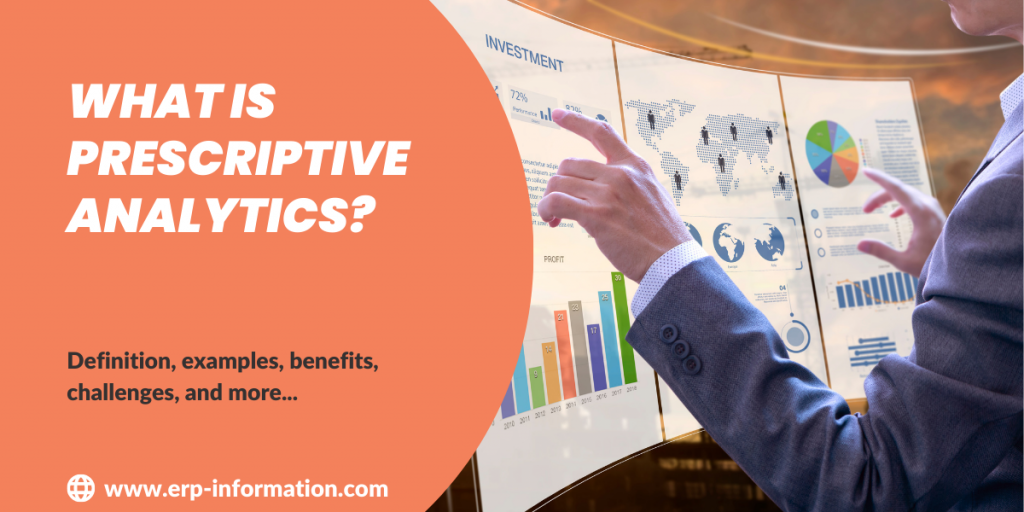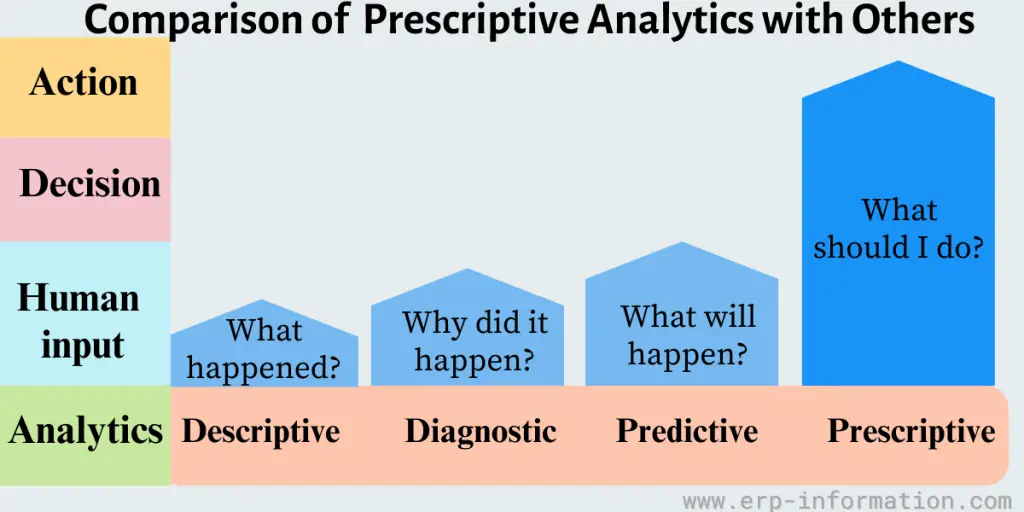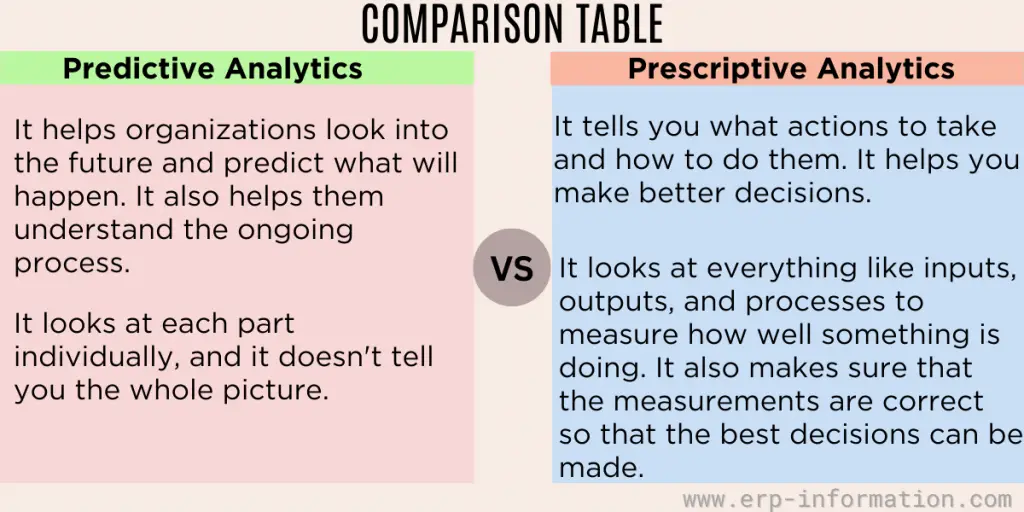Prescriptive analytics is the kind of data analysis that helps businesses make more efficient decisions. Predictive and descriptive analytics are the other two analytics that helps data analysis.
Prescriptive analytics is intended to answer questions about how things will change in the future. The program combines data collected from the past with machine learning results to predict possible future directions.
This blog post emphasizes prescriptive analytics, how it works, examples, tools, future, benefits, and challenges.
What is prescriptive analytics?
Prescriptive analytics is a way to use data to make the best decisions for your business. It looks at what has happened and then figures out what could happen. It tells you the best thing to do for your business to succeed.
This analytics can help you decide how to take advantage of an opportunity or avoid a risk. It uses descriptive and predictive analytics information to help you make the right decision.
How does prescriptive analytics work?
In order to use an analytics tool, there needs to be a specific algorithm model and instructions for the user. Without knowing how to fix a problem, it is hard to come up with an answer.
For example, If a human resource manager needs to train someone but does not have all the needed skills, prescriptive analysis can help him figure out how much progress has been made.
- It uses AI (Artificial intelligence) and ML ( Machine learning) to understand past data and future analysis.
- It works with predictive and descriptive analytics and uses statistics and modeling for better future analysis.
- Prescriptive analytics is like a scale. It can do small things like say yes or no, tell you how much inventory to have, change prices or buy stocks depending on the market.
Examples of prescriptive analytics
This analytics is not just a trend or phrase. It does not just belong to big companies. It is a very detailed type of data analysis. It requires special processes. It provides information about the consumer and financial, wholesale, and retail markets.
It can change with the changing economy to be up-to-date. Many companies use prescriptive analytics to improve processes and help their customers have better experiences.
It is useful for side trades. It helps them to understand customer behavior. Sidetrade uses special calculations to determine how likely clients will pay their bills on time. This helps Sidetrade and its clients be sure that payments will not be late and cost extra money.
- A financier can use the loan approval engine tool that helps decide if someone can get a loan. It determines the person’s income, credit score, and job.
- Anyone planning to analyze the product to buy can take the help of a product recommendation engine. It helps you find other products to buy. It looks at what you have bought before and what similar customers bought.
- A fraud management application can decide if a purchase or transaction can be approved. They look at the type of transaction, how much it is for, where it is from, and the buyer’s history.
- Social media analytics tools can help you know how well your social media marketing is going. You can use them to create reports to show people how it is doing. They also give you data from the past that you can use to ensure your plan is working both in the long and short term.
Benefits
- Prescriptive analytics can help you find the best path to success. It pulls data and information together so you know what to do and how to do it right.
- Artificial intelligence takes over business intelligence and can show you what steps to take to achieve your goal or avoid failure.
- It enables us to show business operations in real time and for the future.
- It helps the leaders to look past and future and decide what is best for success. This makes it easier to make decisions by giving good advice.
- Data analysis and outcome predictions can be made quickly to find problems faster.
- Artificial intelligence can help you look at data faster than your team of data engineers, and it will take much less time.
- It collects and studies data that can be more accurate than what people or descriptive analytics can do.
- It uses smarter algorithms and machine learning to reduce mistakes or unfairness.
- It can help reduce fraud, limit risks, and increase efficiency.
- It helps people make decisions based on facts instead of guesses. So businesses can be more successful, and customers will be happier.
Challenges
- Prescriptive analytics is not perfect. It works only if you ask the right questions and know how to act on the answers.
- It needs good input data so that the results are accurate. If the assumptions are wrong, then the output won’t be correct.
- It is not good for making long-term decisions. It is only good for finding solutions quickly. The longer you use it, the less reliable it becomes.
- Bad decisions can cause bigger problems with prescriptive analytics. This could be seen in the stock market when automated trading caused it to crash.
- Prescriptive models need special tools and ways to track what is happening and make necessary changes.
- Sometimes bias can be put into prescriptive analytics models, which can worsen when the system is automatic.
- Prescriptive models need a system and processes that work well and can be adjusted as needed. They also need to be monitored carefully.
Future
Big data and better technology will drive prescriptive analytics in the future. People may not like it because of privacy concerns, and there could be risks of bias or discrimination. These issues might stop people from using prescriptive analytics.
Big data is growing, which means companies can use data in new and better ways to make decisions.
For example, some businesses use information from social media and other sources when deciding whether to loan to someone without a traditional credit score. Companies can also analyze lots of data quickly with the help of enterprise data catalogs and other techniques.
A prescriptive model may help the people working together to help businesses measure how their decisions affect the environment, people, and laws.
Companies now offer services that can tell them how their supply chain affects the environment, use satellite pictures for business decisions, and discover when private information is shared without permission.
Prescriptive analytics tools
Many tools are available in the market for better data analytics. A few examples are listed below.
- Tableau
- KNIME
- RapidMiner
- Alteryx
- Microsoft Azur
- IBM Cognos analytics
- Dataiku
- Looker
Difference between predictive analytics and prescriptive analytics
Predictive analytics helps you guess what might happen in the future. Prescriptive analytics helps you decide what to do based on your collected data. Both are important for making good business strategies.
Conclusion
Prescriptive analytics is an important tool that can help make organizational decisions more efficient and organized. It provides many different analysis studies to use effectively and for maximum benefit.
Although there are always challenges associated with initiatives like this, these implications can be mitigated through proper implementation planning and a clear mission statement about the desired results.
The prescriptive analysis enables individuals and society to make more informed decisions that could save lives while preserving resources by promoting expertise, operational execution, understanding customer needs, and making quick decisions in dynamic situations.


